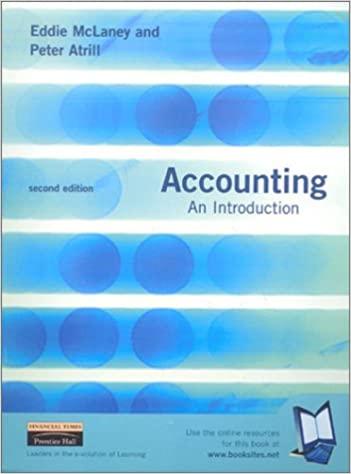Answered step by step
Verified Expert Solution
Question
1 Approved Answer
Financial statements for Rundle Company follow. RUNDLE COMPANY Balance Sheets As of December 3 1 Year 4 Year 3 Assets Current assets Cash $ 2
Financial statements for Rundle Company follow.
RUNDLE COMPANY
Balance Sheets
As of December
Year Year
Assets
Current assets
Cash $ $
Marketable securities
Accounts receivable net
Inventories
Prepaid items
Total current assets
Investments
Plant net
Land
Total assets $ $
Liabilities and Stockholders Equity
Liabilities
Current liabilities
Notes payable $ $
Accounts payable
Salaries payable
Total current liabilities
Noncurrent liabilities
Bonds payable
Other
Total noncurrent liabilities
Total liabilities
Stockholders equity
Preferred stock, par value $ cumulative, nonparticipating;
shares authorized and issued
Common stock no par; shares authorized; shares issued
Retained earnings
Total stockholders equity
Total liabilities and stockholders equity $ $
RUNDLE COMPANY
Statements of Income and Retained Earnings
For the Years Ended December
Year Year
Revenues
Sales net $ $
Other revenues
Total revenues
Expenses
Cost of goods sold
Selling, general, and administrative
Interest expense
Income tax expense
Total expenses
Net earnings net income
Retained earnings, January
Less: Preferred stock dividends
Common stock dividends
Retained earnings, December $ $
Required
Calculate the following ratios for Year and Year
a Working capital.
b Current ratio. Round your answers to decimal places.
c Quick ratio. Round your answers to decimal places.
d Receivables turnover beginning receivables at January Year were $Round your answers to decimal places.
e Average days to collect accounts receivable. Use days in a year. Round your intermediate calculations to decimal places and your final answers to the nearest whole number.
f Inventory turnover beginning inventory at January Year was $Round your answers to decimal places.
g Number of days to sell inventory. Use days in a year. Round your intermediate calculations to decimal places and your final answers to the nearest whole number.
h Debttoassets ratio. Round your answers to the nearest whole percent.
i Debttoequity ratio. Round your answers to decimal places.
j Number of times interest was earned. Round your answers to decimal places.
k Plant assets to longterm debt. Round your answers to decimal places.
l Net margin. Round your answers to decimal places.
m Turnover of assets average total assets in Year is $Round your answers to decimal places.
n Return on investment average total assets in Year is $Round your answers to decimal places.
o Return on equity average stockholders' equity in Year is $Round your answers to decimal places.
p Earnings per share total shares outstanding is unchangedRound your answers to decimal places.
q Book value per share of common stock. Round your answers to decimal places.
r Priceearnings ratio market price per share: Year $; Year $Round your intermediate calculations and final answer to decimal places.
s Dividend yield on common stock. Round your answers to decimal places.
Step by Step Solution
There are 3 Steps involved in it
Step: 1

Get Instant Access to Expert-Tailored Solutions
See step-by-step solutions with expert insights and AI powered tools for academic success
Step: 2

Step: 3

Ace Your Homework with AI
Get the answers you need in no time with our AI-driven, step-by-step assistance
Get Started


